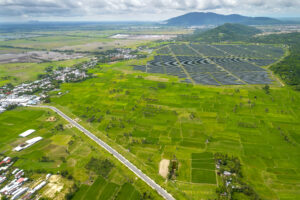
Using Geospatial Technology To Implement Renewable Energy Solutions
Energy conservation is crucial in space, where even a single watt cannot be wasted. Space engineers are incredibly mindful of energy usage and strive to preserve every microwatt. They have achieved exceptional levels of efficiency and are now sharing their expertise for use in various applications on Earth.
Finding solutions to the energy challenge is a pressing issue for our planet, and space technology can help to address it. The space industry is at the forefront of developing renewable energy sources. A prime example is solar cells, which were initially introduced to power satellites while in orbit.
Satellites and satellite imagery analytics by reliable providers like EOSDA can also be used to find suitable sites for implementing renewable energy hardware, including solar panels, wind turbines, etc… It’s possible now to use navigation systems that help us travel more efficiently thanks to satellites.
Additionally, teleconferences make communication possible without the need for travel, which helps conserve a significant amount of energy.
Space monitoring technology
EOS Data Analytics specializes in satellite-based remote sensing and advanced data analysis. The company creates software and offers services that assist customers in automating and streamlining operations, resulting in improved profitability and reduced environmental impact.
EOSDA offers pre-made solutions and customized projects addressing nine of the United Nations’ 17 Sustainable Development Goals, including climate action, responsible production and consumption, and ending hunger. The company prioritizes these goals in the development and improvement of its products. Additionally, EOSDA participates in social projects that align with these goals.
Solar energy is experiencing unprecedented growth as the most rapidly expanding alternative energy source worldwide. To accurately assess trends, market size, and market share, governments and industry players must closely monitor solar plant proliferation.
EOS Data Analytics has developed an innovative algorithm that leverages remote sensing imagery analysis to address this need. This algorithm generates a comprehensive mosaic of the globe every two weeks, enabling the identification and quantification of solar plants. It further calculates essential metrics such as plant size, average performance, and other interest factors.
This groundbreaking approach empowers governments and market players by providing precise market size and share information.
Sources of renewable energy: solar power
Solar energy is a plentiful and sustainable power source with significant potential to reduce greenhouse gas emissions. It involves harnessing sunlight through various methods such as photovoltaics (PV), concentrating solar thermal devices, and experimental technologies to generate electricity. The accurate measurement and modelling of broad-spectrum solar radiation play a crucial role in assessing and implementing this type of system.
Solar energy applications encompass diverse fields such as architecture, urban planning, agriculture, horticulture, solar thermal, and electricity generation. It supplies electricity to residences, businesses, educational institutions, and space vehicles.
EOS DATA Analytics has created a remote sensing imagery analysis algorithm that generates a global mosaic every two weeks. This algorithm is capable of determining the number of solar plants and calculating various factors, including their size, average performance, and more.
Furthermore, the adoption of solar energy is rapidly increasing by 25% annually, primarily driven by the escalating costs of conventional energy sources. Geospatial technology has emerged as a vital tool for evaluating and deploying solar renewable energy systems, necessitating careful considerations of functionality, sustainability, and usability.
Although some research has begun to explore the capabilities of modelling and assessment systems, more attention should be given to this aspect. It significantly influences the modelling of solar energy systems and assessing the photovoltaic potential for effective energy management. Precisely evaluating such projects relies on spatial analysis of available resources, which can be conveniently performed using a Geographic Information System (GIS).
Wind, geothermal, and bioenergy
Wind energy is generated using the kinetic energy of moving air through wind turbines. These turbines are situated on land (onshore) or in bodies of water such as seas or freshwater (offshore). Although the concept of wind energy has been around for centuries, technological advances have led to the development of taller turbines and larger rotor diameters, resulting in increased electricity production.
Wind energy has great potential worldwide, exceeding global electricity production. Even remote locations possess ample potential for significant wind energy deployment, with offshore wind power offering tremendous potential.
Geothermal energy is obtained by extracting heat from the Earth’s internal thermal energy through wells or other methods. It can come from natural hot and permeable hydrothermal reservoirs or be created through hydraulic stimulation in enhanced geothermal systems.
Satellite remote sensing is an effective way to identify and explore geothermal energy-suitable sites. It’s a low-cost and easily accessible alternative to the traditional drilling method, with short repeat times. SAR satellite remote sensing can guide exploration and the setup of geothermal power plants in different locations. It can map and explore potential geothermal areas through remote currency measurement methods.
SAR satellite imagery uses reflections and scattering to gather data on Earth’s surface for geological studies. Advances in measurement tools and digital processing have been made with increasing EO satellites. Thermal infrared sensors detect geothermal potential through features like hot springs and fumaroles. These portable sensors can map temperature and heat fluctuations in remote areas.
Biomass has been used throughout history for heat and light production, both directly and indirectly. Burning biomass to generate energy does produce greenhouse gas emissions but at levels lower than burning coal, oil, or gas.
However, it’s essential to limit the use of bioenergy due to the potential negative impact on the environment caused by widespread forest and bioenergy plantation growth, leading to deforestation and land-use changes. The production of biomass, which includes natural materials from trees and agricultural products, can help increase energy sources’ sustainability.